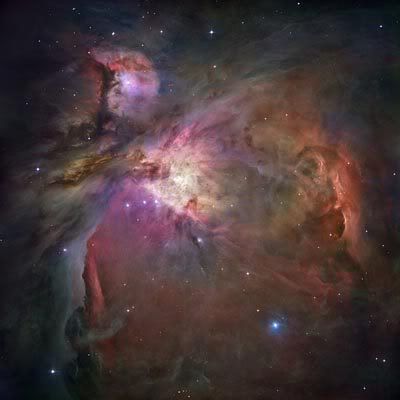 The Pleiades star cluster, also known as the Seven Sisters and Messier 45, is a conspicuous object in the night sky with a prominent place in ancient mythology. The cluster contains hundreds of stars, of which only a handful are commonly visible to the unaided eye. The stars in the Pleiades are thought to have formed together around 100 million years ago, making them 1/50th the age of our sun, and they lie some 130 parsecs (425 light years) away. From our perspective they appear in the constellation of Taurus, with approximate celestial coordinates of 3 hours 47 minutes right ascension and +24 degrees declination. For northern hemisphere viewers, the cluster is above and to the right of Orion the Hunter as one faces south, and it transits -- reaches its highest point in the sky, midway between rising and setting -- around 4am in September, midnight in November, and 8pm in January.
The Pleiades star cluster, also known as the Seven Sisters and Messier 45, is a conspicuous object in the night sky with a prominent place in ancient mythology. The cluster contains hundreds of stars, of which only a handful are commonly visible to the unaided eye. The stars in the Pleiades are thought to have formed together around 100 million years ago, making them 1/50th the age of our sun, and they lie some 130 parsecs (425 light years) away. From our perspective they appear in the constellation of Taurus, with approximate celestial coordinates of 3 hours 47 minutes right ascension and +24 degrees declination. For northern hemisphere viewers, the cluster is above and to the right of Orion the Hunter as one faces south, and it transits -- reaches its highest point in the sky, midway between rising and setting -- around 4am in September, midnight in November, and 8pm in January.~~~~~~~~~~~~~~~~~~~~~~~~~~~~~
ALDEBARAN (Alpha Tauri). Aldebaran is by far the brightest, and therefore the Alpha, star of the constellation Taurus. The ancient name, from Arabic, means "the Follower," as the star seems to follow the Pleiades, or Seven Sisters star cluster, across the sky. Aldebaran, 60 light years away, is positioned in front of the sprawling Hyades star cluster (in mythology, half-sisters to the Pleiades) that make the face of Taurus the Bull, but is not a part of it, the cluster over twice as far away. In most renderings of the constellation, Aldebaran makes the celestial Bull's eye. As part of a constellation of the zodiac, Aldebaran is close to the Sun's path, the Sun passing to the north of it about June 1, the star also regularly covered, or occulted, by the Moon. This class K star, of first magnitude and 13th brightest in the sky, is a low- level irregular variable star that fluctuates erratically and to the eye unnoticeably by about two-tenths of a magnitude. Aldebaran's surface temperature of just under 4000 degrees Kelvin (compared to the Sun's 5800 degree temperature) gives it a distinct orangy color. It is a giant star, a star in an advanced state of evolution in which the interior hydrogen fuel has run out, the star now running on the fusion of helium into carbon. Some 350 times more luminous than the Sun, it has expanded to a radius about 40 times solar, making it big enough to enable astronomers to measure its small angular diameter of only 0.021 seconds of arc (the apparent size of a US nickel seen at a distance of 50 kilometers). This large star is an extremely slow rotator, taking almost two years to make a full spin. If placed at the position of the Sun, Aldebaran would extend halfway to the planet Mercury and would appear 20 degrees across in our sky, making life on Earth quite impossible. Yet Aldebaran may have its own "solar system." Recent, though still-unconfirmed, observations show that the star may be slightly shifting back and forth in response to a small body with a mass at least 11 times that of Jupiter and a two-year orbital period. We do not yet know if the body -- if it exists at all -- is a massive planet or a low-mass "brown dwarf," a failed star that is too small to run supporting thermonuclear reactions in its core.
Source: Jim Kaler, Professor Emeritus of Astronomy, University of Illinois
Source: Jim Kaler, Professor Emeritus of Astronomy, University of Illinois





No comments:
Post a Comment